„Zusammen ergeben sie die Welt, in der wir leben“
(Max Beckmann)
The 13 pictures of the “TRANSIT” cycle
With his 2021 cycle “TRANSIT”, Albrecht Gehse accomplishes a departure towards new painterly positions. Elaborately painted passages are placed abruptly next to improvised ones. Here a three-dimensional figure, there a figure treated like a sketch with a casual brushstroke.
Its open and hence amorphous imagery distinguishes this cycle fundamentally from “Turmoil – 50 Pictures of the World” (2016). In “TRANSIT”, more than ever, the artist attempts to capture society using a multitude of fantastic themes and unique metaphors. While opening his visual language and working with reduction, Gehse creates highly free compositions. The pictures from “TRANSIT” seem strikingly effortless, without compromising their intellectual emphasis.
In his paraphrasing of the term TRANSIT, - the artist also covers the political angle, the crossing over to the realm of freedom, a passage through unhospitable terrain.
Naturally, these denotations – right to the translation of “passage” as the refugee routes of today – all resonate, but by Albrecht Gehse inserting himself as medium for that “gateway”, the topic of TRANSIT becomes larger and wider. Compared to TURMOIL, he once again formally opens his process of finding images and, in a highly visible manner, lets the light stream into the uninhabited image space.
Compared to TURMOIL, he once again formally opens his process of finding images and, in a highly visible manner, lets the light stream into the uninhabited image space.
(Michael Hametner)
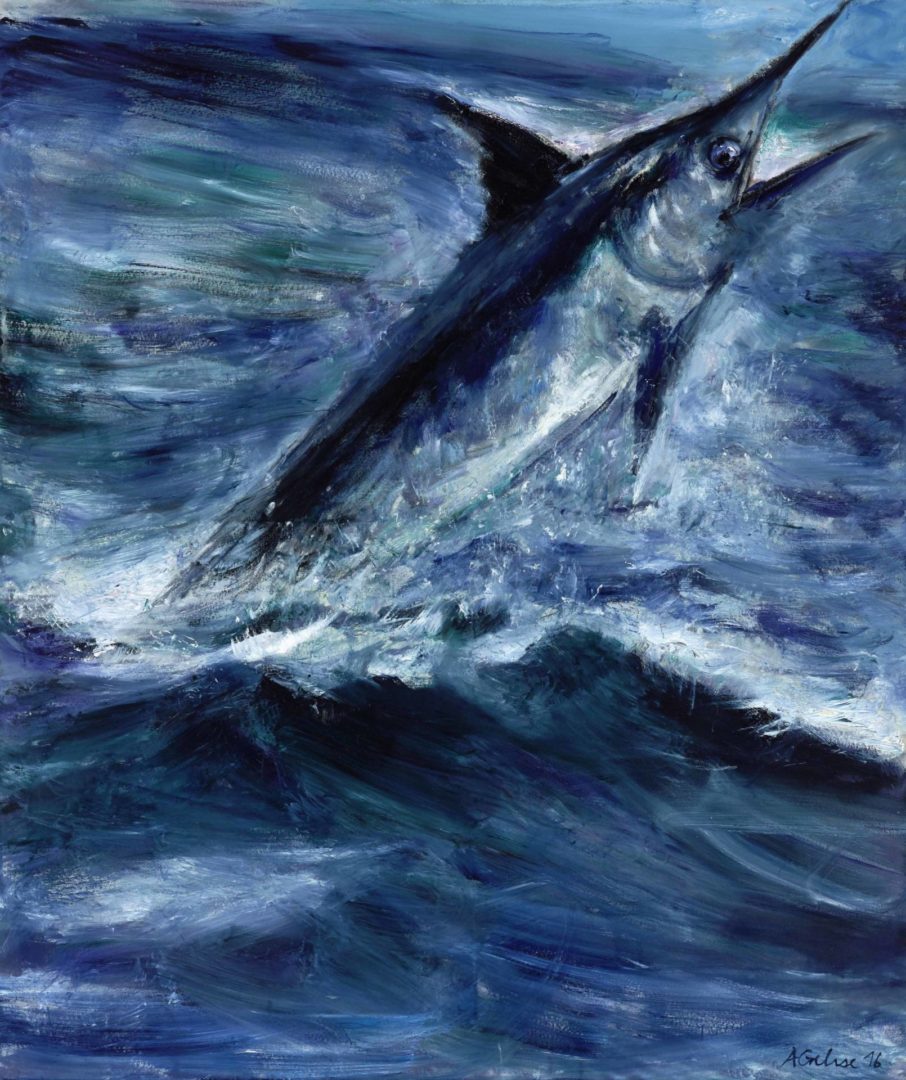
Prologue - JUMPING FOR AIR (Caper)
Albrecht Gehse introduces his cycle with a marlin jumping from the ocean, entitling the picture “Luftsprung” (double meaning in German: “jumping for air / caper, bounce”). Unlike in his picture series “TURMOIL”, Gehse reveals his readiness to play – the game of irony and high jinks. Me, the angler, or me, the fish, jumping for air. Perhaps it is a jump for joy. Clashing with this interpretation, however, is the dominating blue, imparting coolness and distance. A contradiction hinting at something profound, which the painter – legitimately, at this prelude stage – leaves to be specified. To the artist as ocean angler, the primordial metaphor is familiar: the endless expanse of moving waters, from which suddenly a fish arises, reminding us that under the surface, another world exists, invisible to us and far away. This image signifies a journey into this “other world” – the world of his thoughts and visions. Let the passage (= transit) begin.
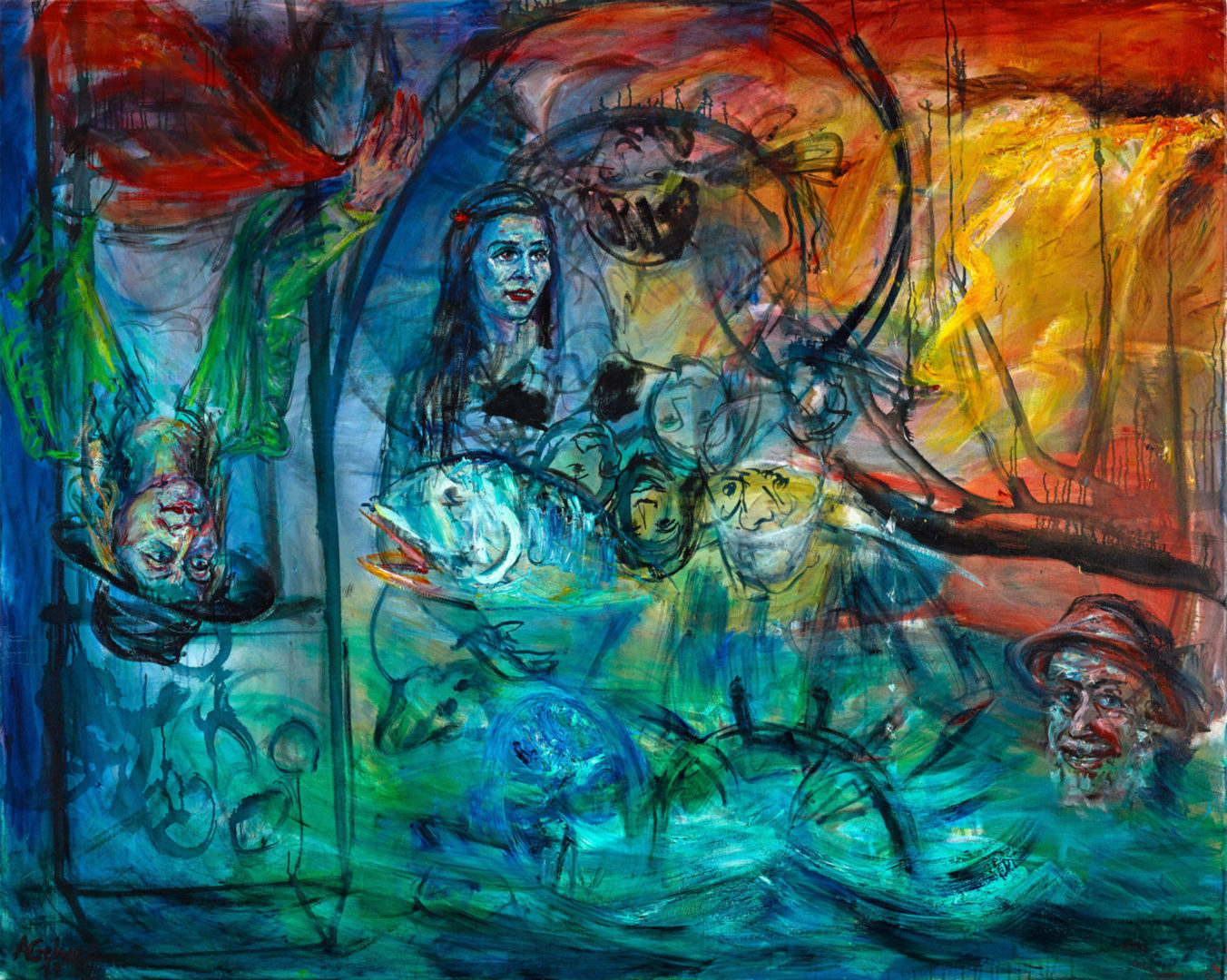
As high as the waters rise
The picture AS HIGH AS THE WATERS RISE, which opens the cycle, clearly marks the transition from TURMOIL to TRANSIT. We still see the dense arrangement but there remain free spaces in this “underwater world”. While they are not distinguished by colour – imagine a high tide, a deluge, the Flood, an aquarium at best –, they are integrated with varying intensity. Dominant are the writing attempts with black lines, their up and down swings, which draw connections between differently executed portraits. Perhaps invoking the chaos after a shipwreck? The way Gehse lets a large format appear like a jotted sketch is an extraordinary sign of his artistic abilities.
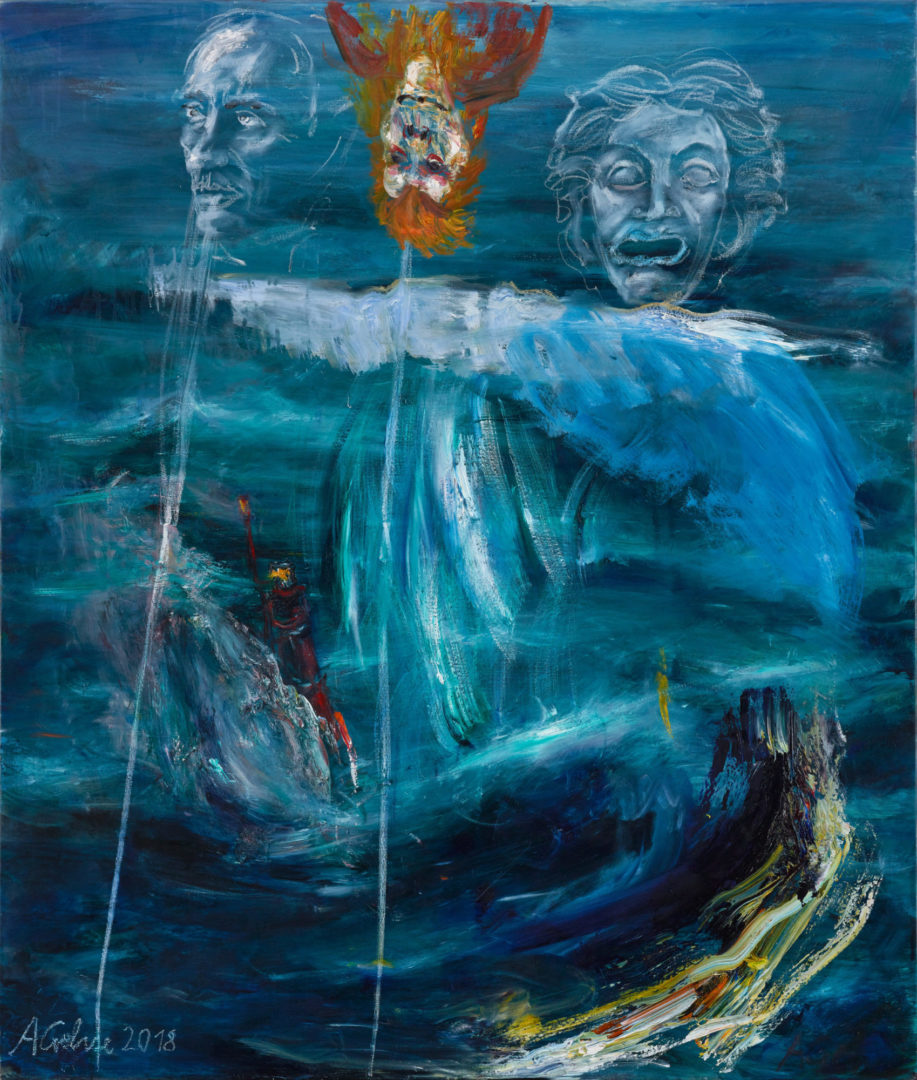
To the theatre in a dugot
In the second picture of the cycle, TO THE THEATRE IN A DUGOUT, he once again uses a main topic of his painting – the sea. Many of his pictures use sea, boats and fish as recurring “water signs” – also symbols of his personal existence as boat owner and skipper. Here, he puts three heads on poles, making them look as if impaled or as stick puppets at the same time. Markedly, the head to the references the theatre with its mouth opened to scream. Is it Medusa's head, who was sacrificed repeatedly by the Gods and who, after her beheading, became a spectre which made even Atlas turn to stone? Which play are these three going to perform? Gehse exposes them to stormy waters, which makes their passage to the theatre uncertain. Perhaps the beholder merely takes refuge in the term “theatre”, hoping this catastrophe would not be happening in real life.

Upwards
Up until 2021 Albrecht Gehse was working on the picture UPWARDS. The basic setting of a party high above the roofs of the city has been differentiated more and more, and ever more precisely he has transformed the portraits into real persons, mostly collectors but also the painter’s daughter Ronja, who frequently appears in his pictures. It’s a boisterous circle that has gathered on the roof terrace, without being decadently distorted. However, the artist denies them the chance to rise to the world of the American natives. The image of the Chief – let’s name him after the honourable Sitting Bull – hovers above the scene, the stairs are drawn up, an Indian symbol at the top to the right acts as a stop sign. The crowd below has to make do with the image of an Indian, which it has spruced up with its head gear almost into an icon. And like others, this picture breathes plenty of air with its expansive, light-stratified sky.
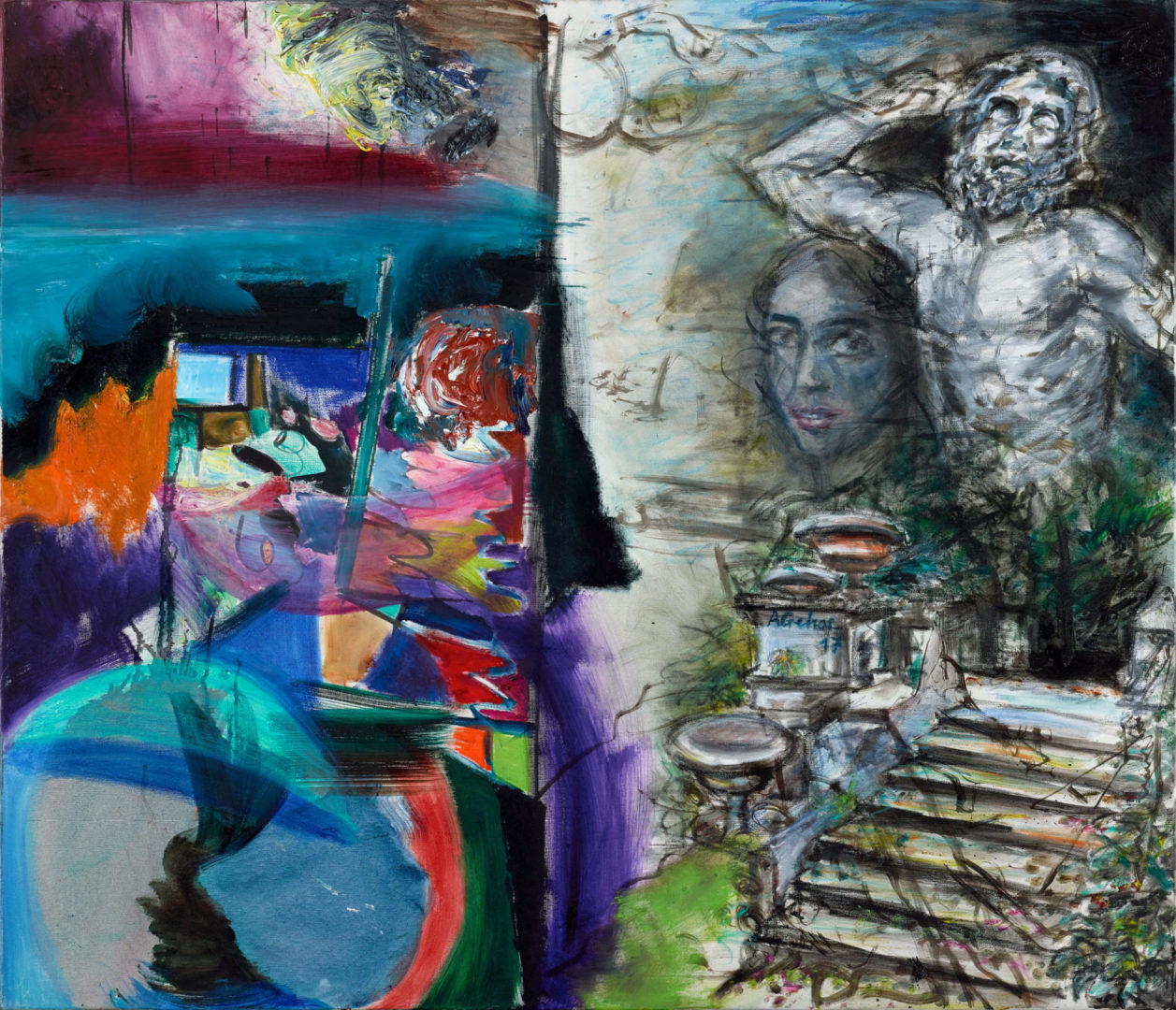
Odyssey of a Painter
Does the painter see himself as Ulysses? If so, he would have reached a crossroads in ODYSSEE OF A PAINTER: to the left the path towards a colourful expressionism and to the right the stairs up to classical figurativeness. Here, Gehse employs a very precisely and consciously set allegory, which identifies this picture as artistic self-questioning. From time to time (as in other pictures), the artist plays with abstract, ornamental and decorative pictorial forms, as if wanting to leave his “scent mark” also in the field of abstraction. Perhaps he will choose in future cycles the “right” path instead of the left – who knows?
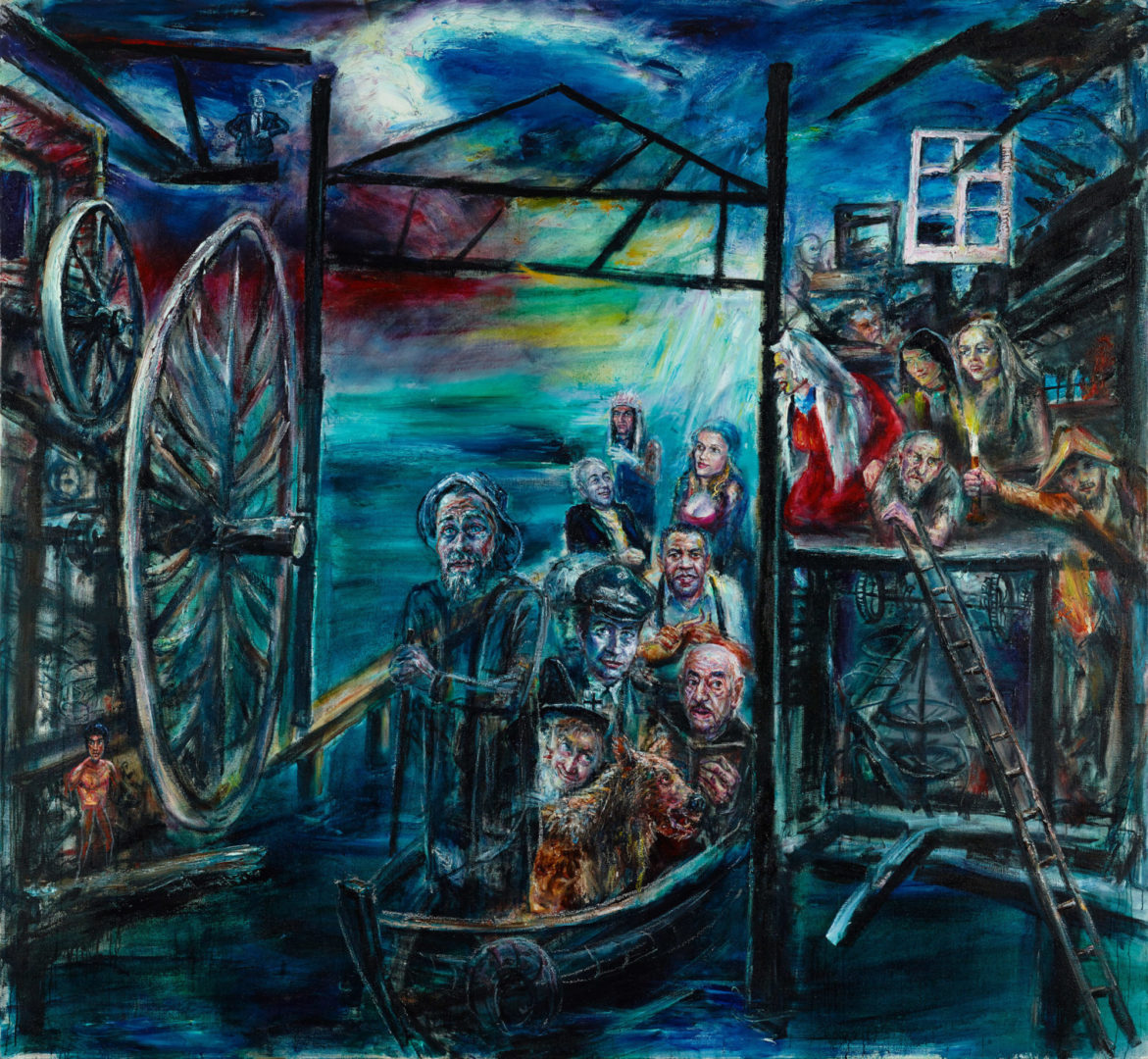
The Ark
he picture THE ARK grew out of another one entitled ARRIVING AT THE MILL. Its reworking shows the influence of Gehse’s engagement with the cycle “WELTFIGUREN”. As in its predecessor, there is a boat in the middle of the picture, now occupied with refugees. Though these are not anonymous heroes. The painter takes the word “occupied” literally, it seems, and assigns the few places in the boat to heroes of his favourite films. The cast appears as if there were no real heroes in our days: all of them movie stars. In this ark we recognize Leonardo DiCaprio as boatswain and to the right the bear which he fights in his role as a trapper, behind the bear’s head the great German film producer Atze Brauner, next to him – of all people – Curd Jürgens with the Iron Cross in Nazi uniform, diagonally behind him Denzel Washington and left overhead Heinz Rühmann, a revealing Scarlett Johansson at his side. Far behind, in the position of navigator, could be “DEFA Indian” Gojko Mitic. And top left in the woodwork of the mill, is that Alfred Hitchcock? And below, is it an armless Bruce Lee on top of a beam next to the big wheel? The unholy family to the right gapes at the newly arrived, perhaps they will shortly demonstrate against this flood of refugees, perhaps they are also people in transit. This picture shows a connection to the visual language in the cycle TURMOIL: the mill becomes the place for an arrested global wheel. Portrait of a society: Germany since 2015.
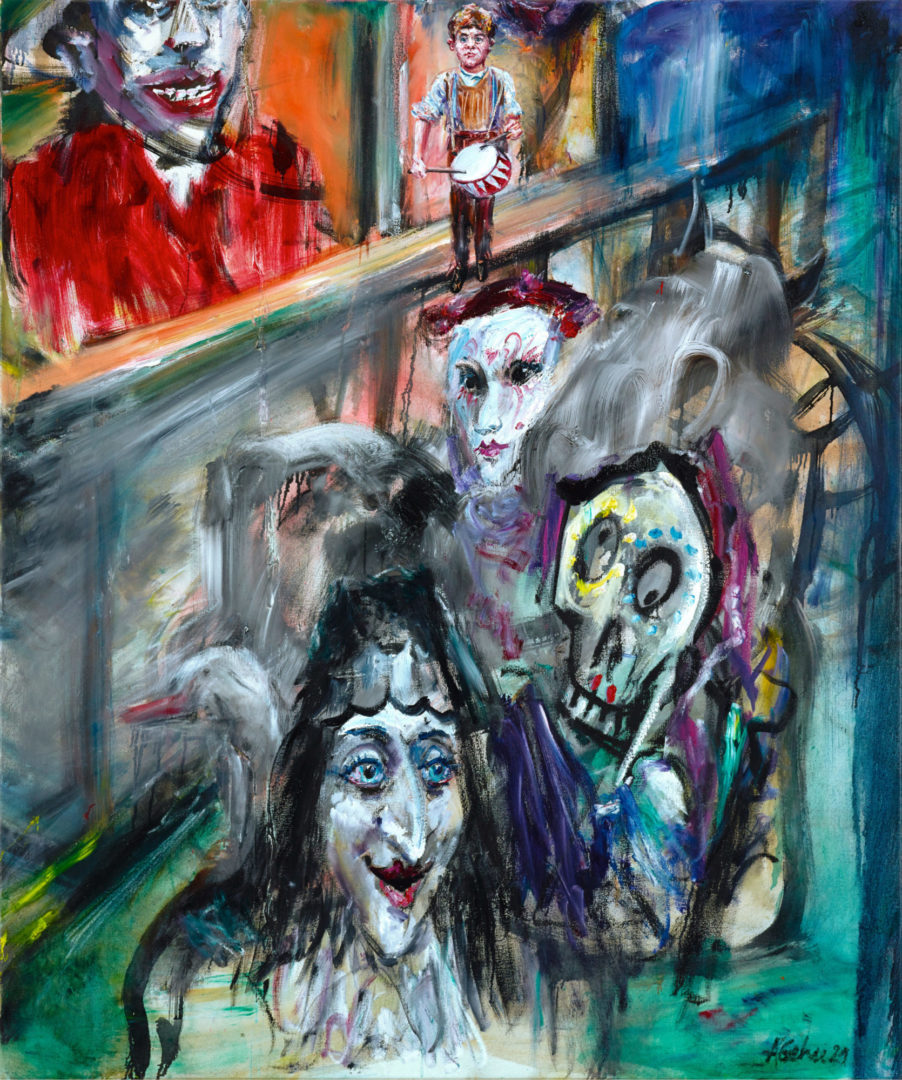
Play the drum
The drummer, which gave the title to the picture PLAY THE DRUM, is actually the most inconspicuous figure of them all. Much more succinct are the three carnival figures. Behind the female figure in the foreground and the skull are some impressive shadowy animals: goose, dog, horse. Another transit situation: the segue from human to animal and back, the carnival experience – to be another for a minute! Referencing in its title the same-named poem by Heinrich Heine, it can be interpreted as an affirmation of a sensuous life: “Kiss the sutler” and “Drum the people from their sleep” – “This is the whole of science, this is the deeper meaning of all books”. Gehse feels legitimised by Heine to create this “picture of rapture”.

The world so loud
THE WORLD SO LOUD displays a closed composition around a head, standing out by its mere size in the centre of the picture. Cavorting around him is a mob of individual figures, real and mythical: at the top left there is Atlas with the globe; below, nude dancers in wild pose; to the left the “hat man” in animated speech; behind, enclosed by railing, two figures with wide open eyes. Above the head of the central figure there is a boat with swelled white sail. Perhaps the painter, departing from the scene? Waving at a figure behind, a passenger at the stern of a leaving ship? The figures are in motion, gesticulating and lending the composition a marked disquiet – “The world so loud”! This setup reappears again and again in Gehse’s compositions. The painter singles out one figure by its size and position and arranges around it – similar to a wimmelpicture – a roundel of details, speaking about the main figure. What is being said, though, remains open.
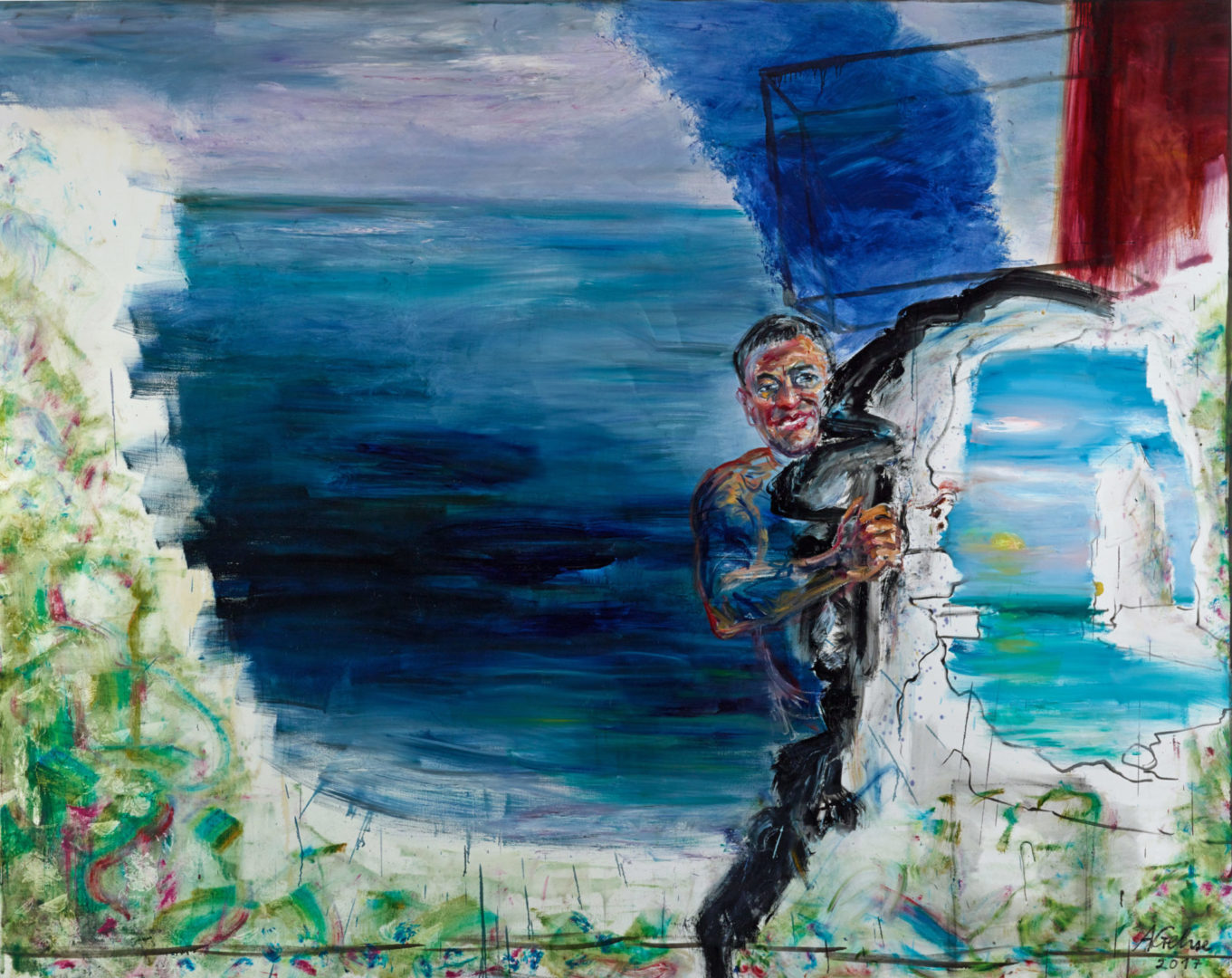
The gate is open
The new visual language can be seen most clearly in the picture THE GATE IS OPEN. To the right, a man holding on to wall remnants, as if he himself had enforced its opening. The other, larger part of the picture: sea and sky. The passageway – another meaning of TRANSIT – is free and the painter lets light and air stream into the picture. Remarkable, how much “world” has come into this open picture: THE GATE IS OPEN was the experience of November 9, 1989, when after 28 years the Berlin Wall opened for the German people. It remains uncertain, if the picture alludes to this key event in German history, which brought a sea change also for East-Germany-born Gehse. In the context of the title TRANSIT, the experience of a divided Germany becomes part of it. There is much more to this image than a glimpse of beckoning South Sees. Gerhard Richter’s statement, according to which an image can be wiser than its painter, seems to come true here, curiously enough in a picture hardly overflowing with sensual references. Apparently, Gehse has accomplished a painterly density which, in terms of content, has taken the lead.

Adjusting to sharks
We can detect once more a critical reference to society in the image ADJUSTING TO SHARKS. The old man crouching to the right in the foreground lifts his head towards a TV screen showing a large shark with pointed teeth. Perhaps the man is looking so intently to prepare for future encounters with sharks – a sort of training for perilous times. Tilting the picture by 90 degrees, another scene is revealed: a family lying in beds or white Styrofoam (the Holy Family again?). Suddenly the picture receives a romantic counterpoint, as if there was still good in the world and one doesn’t have to get familiar with sharks. This picture offers an abundance of meanings to the beholder, which Gehse integrates into a multiperspective composition, without organising them. Impressions remain, separated from another but also simultaneous, not permitting a whole picture. A situation which reflects our own as beholders. As though it was too early for a complex analysis of the phenomena and correlations of our time. The artist primarily follows his extremely amplified sense of vision.
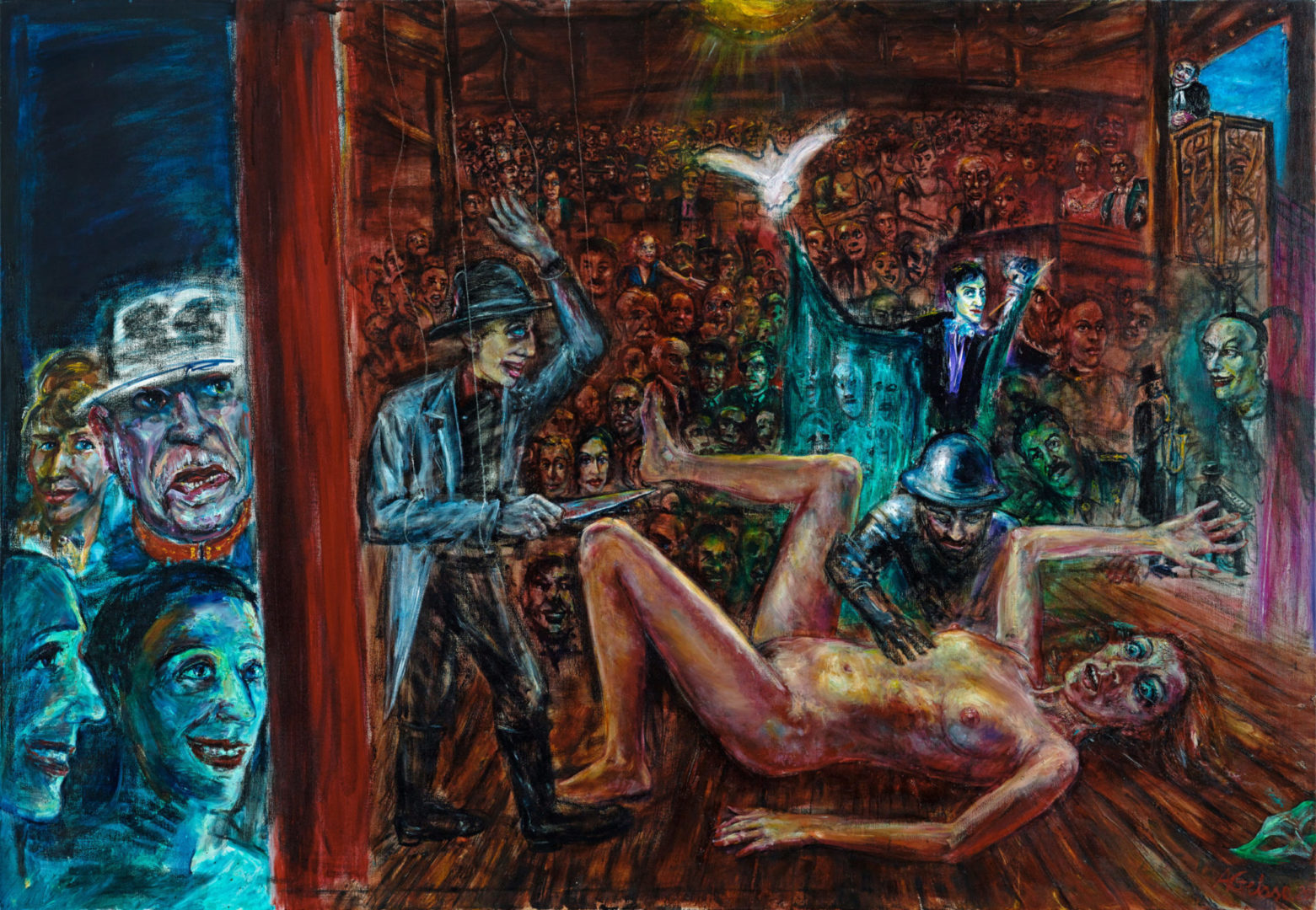
The white dove
The picture THE WHITE DOVE is adopted from the cycle TURMOIL. On its inception in 2015 it was entitled MURDER ON OPEN STAGE. By showing the murdering marionette, by the presence of Mephisto and a magician, the compact scenery is clearly marked as theatre, the depicted death merely a stage death. Yet, the topic is violence, even though purporting to be a public performance in a theatre. Still, the scenery is reminiscent of executions two hundred or more years ago. Violence as thrill, as event for the audience. Dominated by red and black, we are dealing with a highly dramatic picture, charged with bloody violence. There is a disquiet so intense emanating from this image, that the beholder can hardly compensate. The painter decided on a different title: THE WHITE DOVE. He steers our gaze in a different direction. The dove rising from the hand of the magician indicates that we are witnessing a murder on a theatre stage. No blood will run, but red paint. But we live in an era, where play can turn serious at any moment. This is the inner TRANSIT state of our society – and Gehse responds with a nightmare.
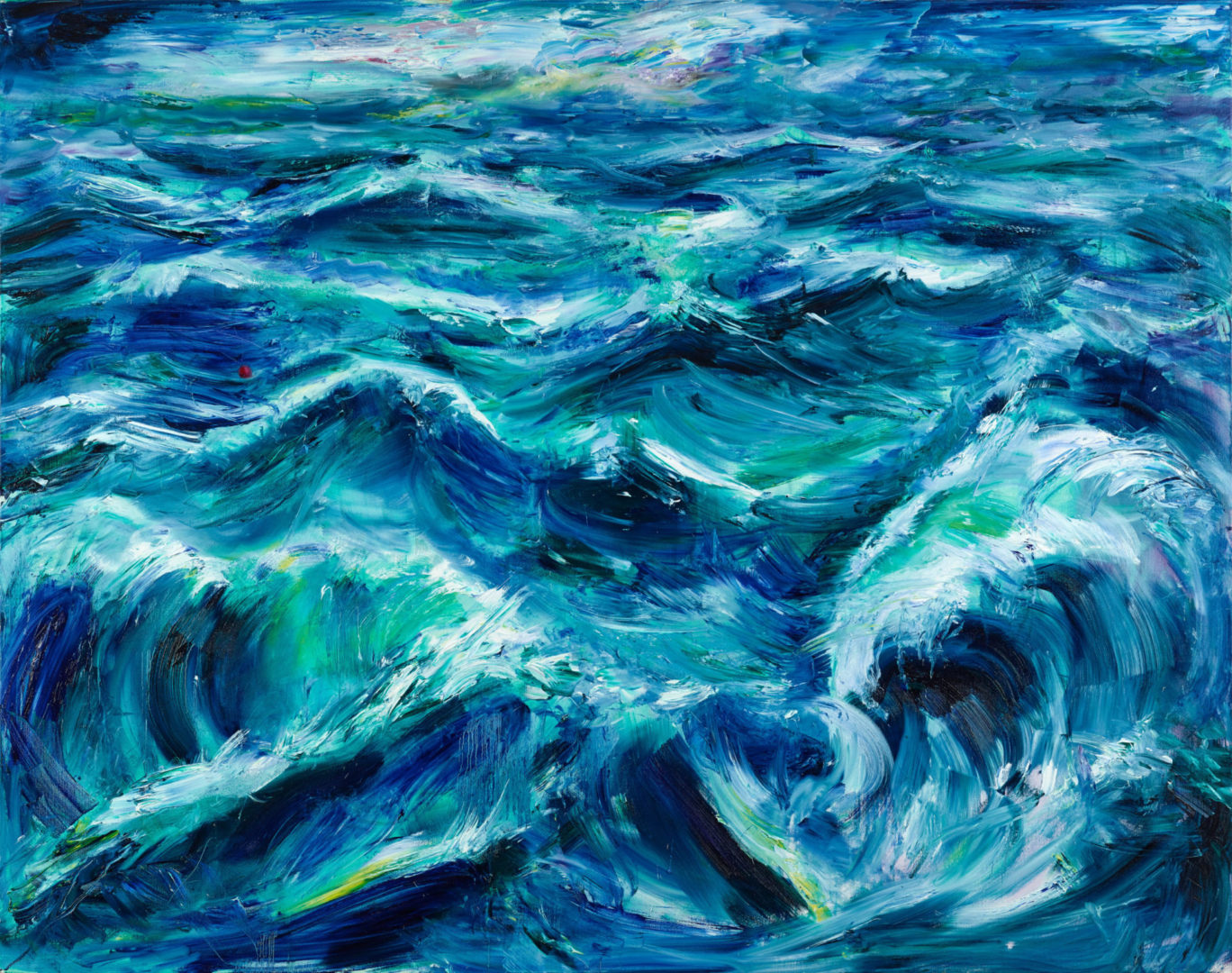
Mayday
At the end of his cycle TRANSIT, the artist places a large ocean piece with the title MAYDAY. As boat owner and skipper – as mentioned before – he is familiar with water. Surely, he would never wish for the forces he bestows on the sea in this picture. Should the beholder assume that colours are allowed to run riot here – the greenish blue of the water, the white of the spray – they would be mistaken. Here, everything is thoughtfully considered, more than in other pictures. Presumably, the process of painting choppy seas is very similar to painting the sky: in the blink of an eye the scenery is a different one. The painter, thus, has to be capable of anticipating the next move. Behind the wave trough runs the crest, attempting to catch up in order to drown it. MAYDAY is the message a ship in distress sends out. Perhaps in this picture, the ship has already been swallowed by the sea. That the waves might be five, six metres high can be discerned by those able to spot the small red ball in the centre of the area to the right. Its tininess demonstrates the size of the waves. At the same time, it might be a sign that this is where a ship went down. A boat of refugees in transit to freedom? The artist will not give this interpretation any more space, but that this sea is not to be taken lightly, still being a refugee route, sticks as a thought in the back of our and the painter’s minds. No need to articulate it.
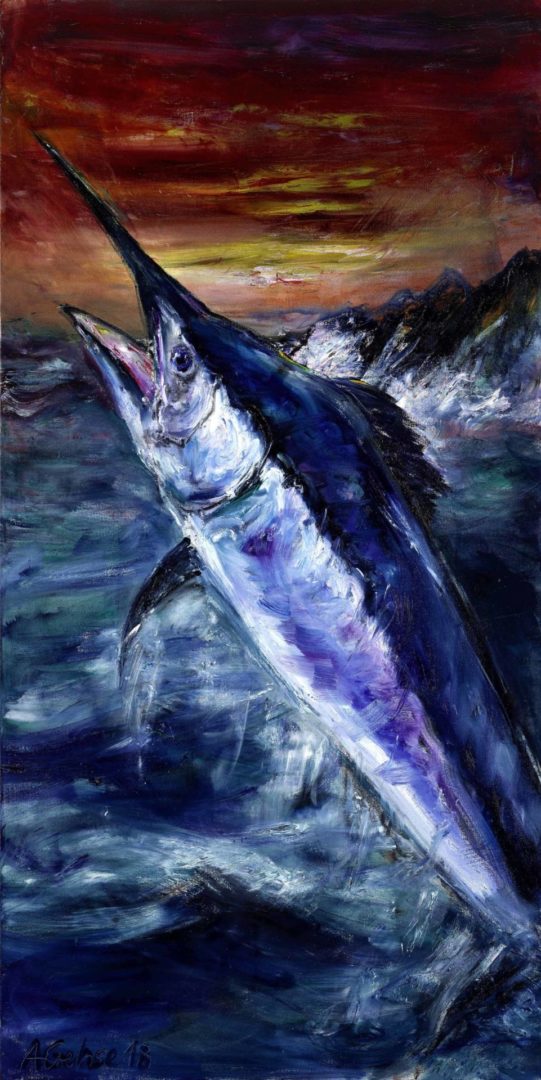
Epilogue - EVENING OF A FISH
The marlin, in all the splendour of its blue-silvery body, is jumping out of the ocean. The intensely red glow of the sky seduced the painter to entitle the picture “EVENING OF A FISH”. Perhaps the artist has painted himself morphed into a fish. Who else could experience this sunset sky, if not the painter himself? Gestures of high jinks and irony – palpable repeatedly in this cycle, accompanied by a sense of doom – find their painterly equivalent in stark contrasts.
In the 13 pictures of the cycle TRANSIT, the artist presents a different visual language. More often than in previous works, he leaves the canvas or its foundation be, while expanding conceptually and formally the horizons of his pictures. Were one to summarise Albrecht Gehse’s 13-piece cycle, one would arrive straight at a thought by Max Beckmann: “Together they reveal the world we live in”. Herein lie the aspiration and appeal of Albrecht Gehse’s exceptional TRANSIT pictures.